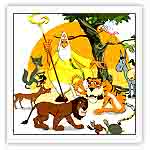HinduOfUniverse
The Panchtantra
The Marvelous Legendary Tales
 Fables are to India what India is to fables. The Panchtantra, and its
auxiliary Hitopadesa, are among the most outstanding collections of
animal fables existing in the world. Over the centuries many of these
stories have found their way out of India in various guises.
Fables are to India what India is to fables. The Panchtantra, and its
auxiliary Hitopadesa, are among the most outstanding collections of
animal fables existing in the world. Over the centuries many of these
stories have found their way out of India in various guises.
Indeed it has been suggested that their influence can be traced not in
the fables of Aesop (this has long been accepted), but also in the
Arabian Nights and various other assorted fables of Spain, Italy and
Greece. One of the reasons for believing this, apart from the special
form and technique of story telling used, is simply the animals that are
mentioned – tigers, monkeys, crocodiles and so on – are alien to many of
these places but are found aplenty in India.
Panchtantra Represents Five Sections
The Panchtantra means five parts (panch, five and tantra, sections) and
has 87 stories. The stories were most probably written down in the
second century BC, although they had been around for a pretty long time
by then, as is evinced by various Sanskrit works.
The framework that the Panchtantra uses is somewhat like the Arabian
Nights – that of weaving a tale within tale. Here the whole thing starts
with a king who wants to knock some sense into his two good-for-nothing
sons. He hires a clever Brahmin teacher who vows to make the boys learn
the ways of niti or practical wisdom over the period of six months. This
is done through simple, though brilliant, fables which always have
morals (in verse format) in the end. The moral of the story is clearly
most important; for the story is made to fit the moral and not the other
way around. Many of these maxims are taken from older books, like the
Vedas, and are sometimes straight quotations.
Some of the axioms from the tales are quite interesting:
Scholarship is less than sense;
Therefore seek intelligence
(Lion Makers)
If a foe commit an outrage on
A house, and one forgives –
Be it from fear or greed – he is
The meanest man that lives.
(The Unforgiving Monkey)
Though mountain, sun and cloud and wind
Were suitors at her feet;
The mouse-maiden turned a mouse again –
Nature is hard to beat.
(Mouse-maiden Made Mouse)
A friend in need is a friend indeed.
Although of different caste;
The whole world is your eager friend
As long as riches last.
(The Duel between Elephant and Sparrow)
All things that are not seen or heard
In science or the Sacred Word
All things in interstellar space
Are known among the populace!
(The Gullible Husband)
|
